In the footsteps of the Battles of Cēsis
Recreation Place “Meža kaujas”, the Main Venues of the Cēsis Battles near the Amata Bridge
Named Forest Battles, the rest area is situated in the main location of the Battles of Cēsis near the Amata bridge. Visitors can listen to stories about the Battles of Cēsis and can take part in various activities, including hikes and trips around the most important venues of the Battles of Cēsis, and team battles. At the end, the visitors can enjoy an invigorating wartime soup. The railway bridge over Amata played a very important role throughout the War of Independence, as the first clashes of the Estonian Army with the Landeswehr took place here. On 5 June 1919, the first battle of the Estonian Army’s armoured trains with the Baltic Landeswehr units took place by the railway bridge over Amata. The Landeswehr, knowing that an armoured train was approaching, planted mines on the railway bridge and secured positions at the homestead Amatas on the riverbank in preparation for a possible battle. The bridge over Amata marked the border between Estonian forces and the Germans. On the night of 23 June 1919, during the Battles of Cēsis, the Landeswehr left Cēsis and retreated to the Amata river line. When retreating, the Germans burned down the Cēsis Latvian Society House and blew up the bridge over Amata.
A unique opportunity is offered to watch the events of June 5, 1919 through virtual reality glasses.
The railway bridge over the river Rauna
The railway bridge over the River Rauna is located near the P20 highway, in Priekuļi parish. It can be viewed from the right side of the Cēsis-Valmiera highway. The railway bridge is not intended for pedestrians and is watched over by security guards. Built in 1889, the masonry bridge on the Riga-Valka railway line is the highest railway structure of its kind in the Baltics. It is 24 metres high and 78.9 metres long. Trains, especially heavy freight trains, must maintain a speed of 80 km/h. Higher speeds are not allowed on the bridge. However, at lower speeds, the train is unable to deal with the slight incline on both sides of the bridge and may start to slide backwards. In June 1919, during the Estonian and Latvian Wars of Independence, reinforcements to the Estonian Army, which also included the Northern Latvian Brigade, were sent by rail across the bridge from Valka, which was at the back of the front. When the 2nd Cēsis Infantry Regiment was forced to retreat from Cēsis, its units strengthened their positions on the banks of the River Rauna. The railway bridge became part of the fortification and ensured the movement of Estonian armoured trains during the battles. During World War II, on 4 July 1941, the bridge was blown up by the fleeing Red Army when the Soviet occupation of Latvia was replaced by the German occupation. German Army sappers restored the bridge within a week. After World War II, during the Soviet occupation, the bridge over Rauna was of military strategic importance and was heavily guarded.
Memorial at Skangaļi Manor
The memorial to the victory of the combined Latvian and Estonian troops in the battle for the Skangaļi Manor is located about 20 kilometres from Cēsis. Devoted to the participants of the Battles of Cēsis and the fighters of the Estonian Kalevlaste Maleva Battalion, the memorial stone was unveiled on 22 June 2019. The victory of the combined Latvian and Estonian troops in the battle for the Skangaļi Manor, which took place here, was a turning point in the Battles of Cēsis, as a result of which the troops of Niedra’s government initiated a general retreat. The government of Andrievs Niedra was a provisional pro-German government of Latvia, which existed from 10 May to 26 June 1919. The attack on the Landeswehr unit began in the early morning of 22 June 1919 when the 3rd Kalev company used an armoured train to break into the Skangaļi Manor where they seized 2 cannons, however, the enemy still went on a counterattack. The troops repeated the attack slightly later, in the middle of the day, and the Landeswehr unit was forced out of the Skangaļi Manor following fierce close combat. The trophies from the battle include machine guns, large quantities of ammunition and other combat equipment. Two hours later, the Estonians captured an important road junction at the Starti pub. 58 Kalev soldiers were injured or lost their lives in the battle to capture the Skangaļi Manor. Estonia provided significant support in establishing the memorial site.
Victory monument in Cēsis
The Victory Monument to Latvians and Estonians killed in the Battles of Cēsis is located in the city of Cēsis, on Vienības Square. In honour of the participants of the 1919 Battles of Cēsis, on 22 June 1924, the first stone was laid for the Victory Monument as sketched by architect Pauls Kundziņš, using funds donated by the people. During the Soviet occupation regime, on the night of 25 March 1951, the monument was blown up and taken down completely. A monument to Lenin, created by sculptor Kārlis Jansons, stood on the former Victory (Unity) Square from 1959 to 1990. In 1997, Māris Niklass, chairperson of the Cēsis District Council, managed to involve Estonian state institutions in the restoration of the monument. The material needed for the construction of the monument, Saaremaa dolomite, was received from Estonia as a gift. On 22 June 1998, during the celebrations of the 79th anniversary of the Battles of Cēsis, the first stone of the monument to be restored was laid on Vienības Square. A ceremony to unveil the restored Victory Monument took place in Cēsis on 15 November 1998 (author: architect Imants Timermanis). Information about the Victory Monument is available in the ‘Cēsis and the Latvian War of Independence’ exhibit of the Cēsis History and Art Museum, in the New Castle.
Monument commemorating the Cēsis battles
The monument to the Estonian and Latvian soldiers who died in the Battles of Cēsis is located in Priekuļi municipality, Liepā, about 1 kilometre south of the Lode Railway Station, on the side of Rūpnīcas street. The first stone of the monument was laid on 22 September 1929, and the monument was unveiled on 11 August 1935. Based on a sketch by Sculptor Augusts Julla who lived in Jullas, Liepa parish, and made of limestone from the village of Allaži, the monument is a high-relief depiction of a peasant soldier leaning on a plough with one hand and a raised sword in the other. The death mask of the sculptor’s father Jānis Julla was used to create the face of the sculpture. According to Aivars Vilnis, a researcher of the history of Liepa parish, a bird’s eye view of the monument reveals that the base of and the path and stairs leading to the monument form the shape of an arrow facing Liepa Manor (Lindenhoff) in the direction of German positions during the Battles of Cēsis. There is doubt, of course, as to whether this was truly the author’s intention at the time; however, it certainly enriches our interpretation of the monument today. Next to the monument are the only natural sandstone arches in Latvia known as ‘Lielā Ellīte’ (‘Liepas Ellīte’ or the Devil’s Kiln).
Monument for students of the Cēsis Regiment
The monument to the soldiers of the Cēsis Regiment Students’ Company who died in the Battles of Cēsis is located in the city of Cēsis, near the intersection of Palasta and Bērzaines streets. The construction of the monument was proposed by the Soldiers’ Association of the Cēsis Regiment Students’ Company. The monument was unveiled on 26 May 1938. The monument is based on the idea sketched by artist Jānis Rozenbergs, a former soldier of the company. Placed on a metre-high limestone pedestal, the 1.8-metre copper sculpture of a soldier dressed in a school student’s uniform was created by sculptor Rūdolfs Āboltiņš and coppersmith Jānis Zibens. An owl, a symbol of wisdom and knowledge, lies at the soldier’s feet, squatting on and protecting the books of a student who went to war. The sculpture was demolished during the Soviet re-occupation in 1952. A monument named the Komsomol Flag Bearer by sculptor Kārlis Jansons was erected near its former location in 1957. Placed near its historic site, the restored monument was unveiled on 11 November 1992. At the same time, in 1992, a monument to the Komsomol, which had been erected by the occupation regime, was taken down.
Virtual reality binoculars "Battle of Cēsis"
The Battle of Cēsis was one of the most significant turning points in the course of the Latvian War of Independence (1918 - 1920). On June 5, 1919, with a clash between armored trains of the Estonian Army and Landeswehr units near the Ieriķi railway station at the bridge over the Amata, the first stage of the Battle of Cēsis began. In commemoration of this event, a tourist attraction has been created near the Ieriķi station, which offers to experience the story of history using the possibilities of modern technology - with the help of virtual reality. The five-minute video “BATTLE AT THE BRIDGE OVER THE AMATA” can be viewed for free every day in virtual reality binoculars. Video duration: 5 min., LV with subtitles LV, ENG, EST and ES.
Cēsis history and art museum in the New Castle of Cēsis
The Cēsis History and Art Museum is located in the very centre of the Old Town of Cēsis, in the New Castle. The museum holds a permanent exhibit of history and interiors named ‘Cēsis, a Symbol of Latvian History’, with two thematic sections: the exhibit ‘Red-White-Red Flag in the History of Cēsis and Latvia’ explains the history of the Latvian national flag from the 13th to 20th centuries, the approved national symbol, the flags of Latvian rifle battalions and the traditions of using national colours during the Latvian War of Independence. The exhibit ‘Cēsis and the Latvian War of Independence’ focuses on the founding of the Cēsis Company in December 1918, the joint battle efforts of Estonians and Latvians in the 1919 Battles of Cēsis, the time when, during the Bermondt Affair, Cēsis served as the temporary capital of Latvia for a short time, as well as the history of the Cēsis Victory Monument. In an escape room named ‘Legends of the Battles of Cēsis’, the participants have one hour to find their way out by solving puzzles, making connections and finding hidden objects. The Cēsis Company, one of the first units of the Latvian Armed Forces, was established on 8 December 1918 in Cēsis Castle by Senior Lieutenant Artūrs Jansons. The museum’s exhibit features a memorial plaque dedicated to the Cēsis Company, unveiled on 8 December 1933 at the Cēsis New Castle, which, at the time, served as the headquarters of the 8th Daugavpils Infantry Regiment and the garrison officers’ club.
Monument for students of the Viljandi Regiment
The monument to the soldiers of the Viljandi Students’ Company who fell near Stalbe is located by the intersection of the Riga-Limbaži road, after making a turn onto the Stalbe-Stūrīši road, which leads to the Pārgauja Municipal Council (to the right). Latvian and Estonian inscriptions on the granite memorial read: ‘On 19-21 June 1919, during the Battles of Stalbe, the 6th Regiment Viljandi Students’ Company repelled the attack of the Germans’. The monument was unveiled on 19 June 2009. Based on the idea conceived by Mareks Niklass, the monument was created by stonemason Voldemārs Koltovs. The 6th Estonian Regiment fought the Baltic Landeswehr and the Iron Division during the Battles of Cēsis near Stalbe. The Germans tried to break the front line in the area of the Stalbe Manor but were forced to retreat after two days of failed attempts. Every year, Lāčplēsis Day celebrations in Stalbe begin with a torchlight procession to the monument devoted to the soldiers of the Viljandi Students’ Company.
Lielstraupe Castle
The Lielstraupe Castle is located in the centre of the town of Straupe. The castle is open to visitors and offers a journey through the centuries along with an orienteering exercise in the labyrinths of the castle. During the Battles of Cēsis, the Lielstraupe Castle housed the command post of Paul Ludwig Ewald von Kleist’s Battle Group of the Iron Division (German: Eiserne Division). During the battles, the castle was visited by Major Josef Bischoff, Captain Heinz Guderian and others. The castle was used for the coordination of an attack in the direction of Stalbe on 21-22 June. The Iron Division was a military force of German mercenaries during the Latvian War of Independence, which was formed from soldiers of the 8th Army of the demobilised German Empire and volunteer mercenaries. It was the best-known part of the German Free Corps and among the best trained and most combat-ready military forces in the Baltics in 1919. During the Soviet period, from 1949 to 1959, the administration of the Lielstraupe Machine-tractor Station operated out of Manor Castle. During this time, the castle was also equipped with training rooms and dormitories for tractor drivers, while the former stable of the manor housed workshops. From 1963 to 2018, the castle was managed by medical institutions, and it was said of the Straupe Narcological Hospital in Latvia that it ‘even treats the walls’.
Monument in memory of the fallen soldiers of the Latvian Liberation War
The monument is located next to Limbaži Sv. St. John's Lutheran Church, Lībiešu Street 2. There is a memorial to the fallen soldiers of Limbaži and the surrounding area and to Lieutenant General Vilis Gelbe (1890-1919), who fell in the battle against the Germans on June 19, 1919 in Vidriži.
The monument of Lieutenant General Viļis Gelbe can be seen in the Limbaži cemetery in Jūras Street.




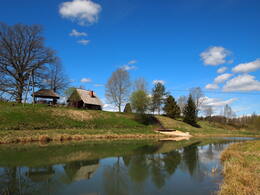
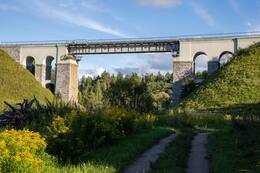
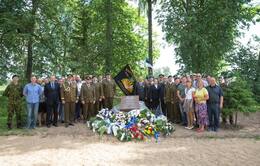
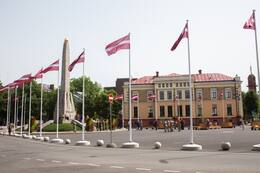
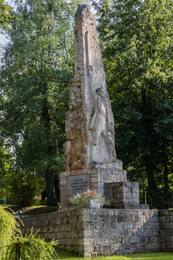
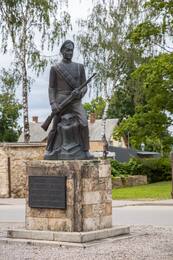
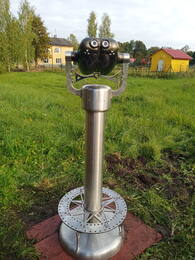
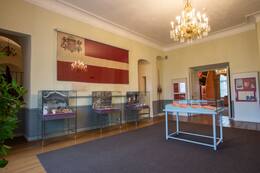
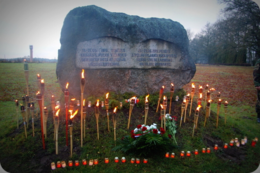
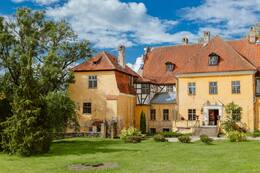
![Limbaži. President J. Čakste unveils a monument in Limbaži to those who fell in World War I. Unveiling of the Latvian Freedom Struggle Monument [1923]. Source: The National Library of Latvia's digital collection "Lost Latvia".](/g/Poi/00403/44213.png?size=260)